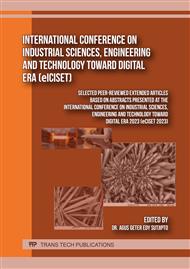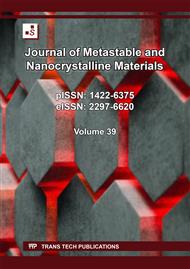[1]
Ü. D. Özgür, V. Avrutin, and H. Morkoç, Zinc oxide materials and devices grown by MBE. 2013.
DOI: 10.1016/b978-0-12-387839-7.00016-6
Google Scholar
[2]
C. J. Frederickson, J. Y. Koh, and A. I. Bush, "The neurobiology of zinc in health and disease" Nat. Rev. Neurosci., vol. 6, no. 6, p.449–462, 2005.
DOI: 10.1038/nrn1671
Google Scholar
[3]
M. A. Borysiewicz, "ZnO as a functional material, a review,"Crystals, vol. 9, no. 10, 2019.
Google Scholar
[4]
R. S. Nicholas Eastaugh, Valentine Walsh, Tracey Chaplin, "The Pigment Compendium."
Google Scholar
[5]
A. Moezzi, A. M. McDonagh, and M. B. Cortie, "Zinc oxide particles: Synthesis, properties and applications,"Chem. Eng. J., vol. 185–186, p.1–22, 2012.
DOI: 10.1016/j.cej.2012.01.076
Google Scholar
[6]
L. Schmidt-Mende and J. L. MacManus-Driscoll, "ZnO - nanostructures, defects, and devices,"Mater. Today, vol. 10, no. 5, p.40–48, 2007.
DOI: 10.1016/s1369-7021(07)70078-0
Google Scholar
[7]
A. G. E. Sutjipto, H. H. Chi, A. Shaitir, and A. Legowo, "High photoluminescence spectroscopy on high purity ZnO crystal growth by electric current heating method,"Mater. Sci. Forum, vol. 981 MSF, p.45–50, 2020.
DOI: 10.4028/www.scientific.net/msf.981.45
Google Scholar
[8]
AF Ling, A Shaitir, A Legowo, AGE Sutjipto. The Effect of Green Body Pressure, Sintering Time and Electric Current on ZnO Crystal Growth by Electric Current Heating Method. Materials Science Forum. 981. 3-10, 2020.
DOI: 10.4028/www.scientific.net/msf.981.3
Google Scholar
[9]
A.G.E. Sutjipto, M.H. Mazwir, H.L. Lee, S. Miskom, A.G. Shaitir, M.A. Jusoh, R. Othman: Effect of Compaction Pressure of Green Body and Heating Current on Photoluminescence Property of ZnO Crystal Grown by Electric Current Heating Method. IOP Conf. Series: Materials Science and Engineering 290, 012043, 2018.
DOI: 10.1088/1757-899x/290/1/012043
Google Scholar
[10]
V. Avrutin, G. Cantwell, J. Zhang, J. J. Song, D. J. Silversmith, and H. Morkoç, "Bulk ZnO: Current status, challenges, and prospects,"Proc. IEEE, vol. 98, no. 7, p.1339–1350, 2010.
DOI: 10.1109/jproc.2010.2040363
Google Scholar
[11]
Y. Zhang, M. K. Ram, E. K. Stefanakos, and D. Y. Goswami, "Synthesis, characterization, and applications of ZnO nanowires,"J. Nanomater., vol. 2012, 2012.
Google Scholar
[12]
M. S. A. Bhuyan, M. N. Uddin, M. M. Islam, F. A. Bipasha, and S. S. Hossain, "Synthesis of graphene,"Int. Nano Lett., vol. 6, no. 2, p.65–83, 2016.
DOI: 10.1007/s40089-015-0176-1
Google Scholar
[13]
A. T. Smith, A. M. LaChance, S. Zeng, B. Liu, and L. Sun, "Synthesis, properties, and applications of graphene oxide/reduced graphene oxide and their nanocomposites,"Nano Mater. Sci., vol. 1, no. 1, p.31–47, 2019.
DOI: 10.1016/j.nanoms.2019.02.004
Google Scholar
[14]
Y. Cui, S. I. Kundalwal, and S. Kumar, "Gas barrier performance of graphene/polymer nanocomposites,"Carbon N. Y., vol. 98, p.313–333, 2016.
DOI: 10.1016/j.carbon.2015.11.018
Google Scholar
[15]
M. Xiao, L. Sun, J. Liu, Y. Li, and K. Gong, "Synthesis and properties of polystyrene / graphite nanocomposites,"vol. 43, p.2245–2248, 2002.
DOI: 10.1016/s0032-3861(02)00022-8
Google Scholar
[16]
S. Pei and H. M. Cheng, "The reduction of graphene oxide" Carbon N. Y., vol. 50, no. 9, p.3210–3228, 2012.
Google Scholar
[17]
B. M. Yoo, H. J. Shin, H. W. Yoon, and H. B. Park, "Graphene and graphene oxide and their uses in barrier polymers,"J. Appl. Polym. Sci., vol. 131, no. 1, p.1–23, 2014.
Google Scholar
[18]
D. Nezaki, M. Yasuda, T. Yasui, and M. Takata, "Selective area growth of ZnO crystals by electric current heating,"Solid State Ionics, vol. 172, no. 1-4 SPEC. ISS., p.353–355, 2004.
DOI: 10.1016/j.ssi.2004.02.069
Google Scholar
[19]
A.G.E. Sutjipto, Y.P. Asmara, M.A. Jusoh: Behavior of MgO Based Ceramics under Electron Irradiation. Procedia Engineering (Elsevier), Vol. 170, pp.88-92, 2017.
DOI: 10.1016/j.proeng.2017.03.017
Google Scholar
[20]
A.G.E. Sutjipto, M. Takata: The use of SEM to investigate the effect of an electron beam on the optically-visible flashover treeing of MgO ceramic. Journal of Materials Science, Springer, 42, pp.6036-6040, 2007.
DOI: 10.1007/s10853-006-1094-4
Google Scholar
[21]
Razi, F. Azreen, A.G.E. Sutjipto, A.S. Mohamad: Development of Cu-SiC composite for electrical discharge machining electrode using powder metallurgy technique. Advanced Materials Research, 576. pp.203-207, 2012.
DOI: 10.4028/www.scientific.net/amr.576.203
Google Scholar
[22]
A.G.E. Sutjipto, T. Okamoto, M. Takata: Appearance of Flashover Treeing on Polycrystal-line Magnesia Surface. Key Engineering Materials, 181-182, p.231, 2000.
DOI: 10.4028/www.scientific.net/kem.181-182.231
Google Scholar
[23]
A.R.F. Azreen, A.G.E. Sutjipto, E.Y.T. Adesta: Fabrication of CuSiC Composite by Powder Metallurgy Route. Advanced Materials Research, 264-265, pp.748-753, 2011.
DOI: 10.4028/www.scientific.net/amr.264-265.748
Google Scholar
[24]
A.G.E. Sutjipto: The Effect of CaO Addition on the Microstructural. Mechanical and Dielectric Properties of Pure MgO Ceramic, Key Engineering Materials, 345-346, p.1609, 2007.
DOI: 10.4028/www.scientific.net/kem.345-346.1609
Google Scholar
[25]
A.G.E. Sutjipto, T. Okamoto, M. Takata, Flashover Treeing of Magnesia Surface under Electron Beam Bombardment in Vacuum. Transaction of the Materials Research Society of Japan, 25(1), p.512, 2000.
DOI: 10.4028/www.scientific.net/kem.181-182.231
Google Scholar
[26]
Jufriadi, A.G.E. Sutjipto, R. Othman, R. Muhida: Discharge, microstructural and mechanical properties of ZrO2 addition on MgO for plasma display panel materials. Materials Research Innovations 13 (3), pp.149-152, 2009.
DOI: 10.1179/143307509x437473
Google Scholar
[27]
A.G.E. Sutjipto, R. Muhida, M.Takata: An SEM Flashover: Technique to Characterize Wide Band Gap Insulators. Proceeding of International Conference on Property and Dielectric Materials 2006, Denpasar, Bali, pp.216-219, 2006. ISBN: 1-4244-0189-5. IEEE Publisher.
DOI: 10.1109/icpadm.2006.284156
Google Scholar
[28]
N. S. Murthy, Scattering techniques for structural analysis of biomaterials. Woodhead Publishing Limited, 2012.
Google Scholar
[29]
S.J. Kim, D.K. Kim, and D.H. Kang, "Using UVC light-emitting diodes at wavelengths of 266 to 279 nanometers to inactivate foodborne pathogens and pasteurize sliced cheese,"Applied and Environmental Microbiology, vol. 82, no. 1. p.11–17, 2016.
DOI: 10.1128/aem.02092-15
Google Scholar



